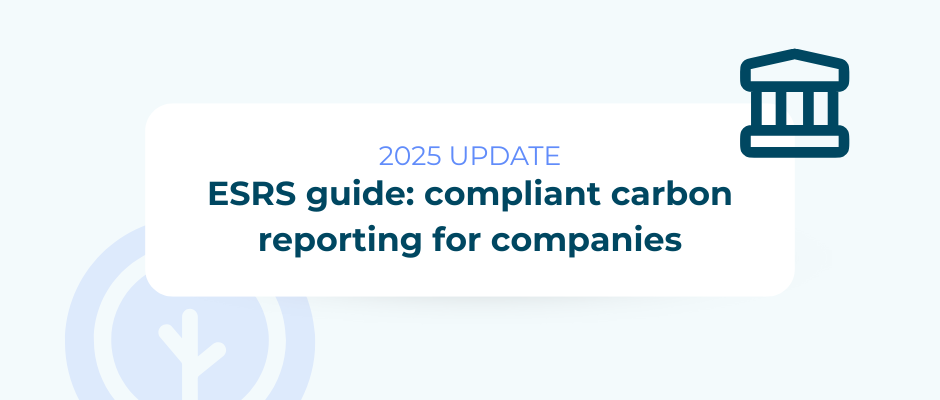ESRS guide (updated 2025): carbon reporting for EU companies
Reading time: 4-5 minutes
Reading time: 4-5 minutes

If your company is preparing a carbon report in Belgium, France, the Netherlands, Luxembourg or the UK, you’ve likely come across the ESRS—the European Sustainability Reporting Standards. These standards, developed to support the Corporate Sustainability Reporting Directive (CSRD), define what sustainability information companies must disclose and how.
Starting in 2024 for wave-one companies, ESRS sets a common framework across Europe. It requires reporting on environmental, social, and governance (ESG) impacts and risks, using a double materiality lens. This means organisations must consider how sustainability affects their business and how their business affects society and the planet.
This article comprehensively analyses ESRS and the latest changes introduced in July 2025. You’ll learn:
The European Sustainability Reporting Standards (ESRS) are the mandatory reporting framework adopted by the European Commission in July 2023. They apply under the CSRD and are designed to ensure companies disclose information on:
Unlike voluntary standards such as GRI or CDP, ESRS reporting is legally required and subject to external assurance.
The CSRD defines who must report and when, while the ESRS defines what and how companies must report. Think of the CSRD as the legal obligation and the ESRS as the detailed rulebook.
Double materiality combines:
For example, climate change might disrupt your supply chain (financial), while your emissions may harm ecosystems (impact). Both must be assessed and reported if material.
The CSRD implementation is phased in four waves:
The full ESRS framework includes 12 sector-agnostic standards:
Each standard has required disclosures—datapoints—companies must include if they are deemed material.
The European Commission adopted a “quick fix” on 11 July 2025 to reduce the burden on wave-one companies. This allows early reporters to omit certain disclosures through FY 2026.
Wave-one companies may:
Companies with >750 employees now get the same exemptions as smaller firms, ensuring a level playing field.
Even when exempt, if a company deems a topic material (e.g. biodiversity), it must include a summary disclosure under ESRS 2. This ensures accountability while easing the data burden.
EFRAG, the body that developed ESRS, published simplified Exposure Drafts on 31 July 2025. These reflect the European Commission’s Omnibus initiative to reduce reporting burdens.
EFRAG reviewed the entire ESRS framework and:
This makes ESRS more usable—especially for smaller teams.
EFRAG applied six main strategies:
The public consultation runs until 29 September 2025. Final drafts will be submitted to the European Commission by 30 November 2025. The revised standards are expected to apply from the financial year 2027.
Whether you’re in scope already or preparing for future waves, here’s how to align your carbon footprint report with ESRS:
Under ESRS E1, companies must report:
Use a recognised methodology like the GHG Protocol to collect data at entity and group levels.
Check if you qualify for temporary exemptions (see “quick fix” rules). Use ESRS 2 to declare if a topic is material, and prepare summaries where complete disclosures are delayed.
The European Sustainability Reporting Standards are becoming the foundation for carbon and ESG transparency across Europe. For companies already in scope—or preparing to be—understanding your obligations and leveraging simplifications is essential.
Thanks to the quick fix delegated act, Wave-one companies have an extended runway. Meanwhile, the simplified ESRS Exposure Drafts promise a more manageable, interoperable, and impact-focused future for sustainability reporting.
If your company operates in Belgium, France, the Netherlands, Luxembourg or the UK and wants to:
now is the time to act.
📢 Tapio can provide you with carbon accounting, data collection, and reporting tools that align with ESRS. Contact us today to get started.
Tapio helps you build a compliant and solid climate strategy for resilient company.